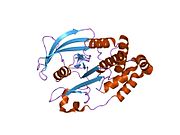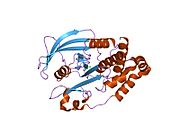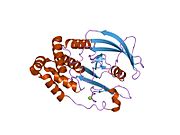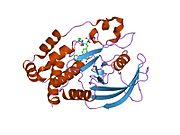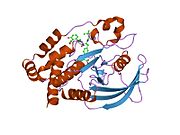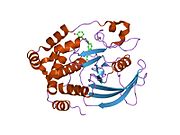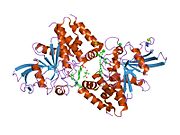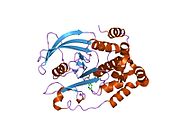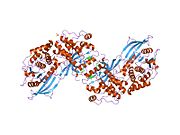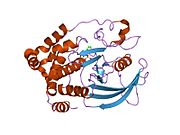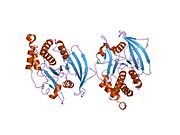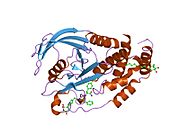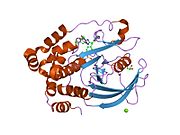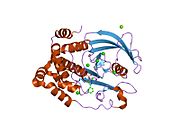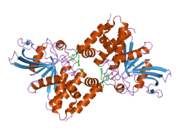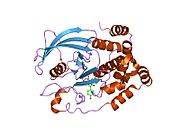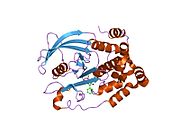PTPN1
PTPN1티로신-단백질 포스파타아제 비수용체 타입 1B(PTP1B)는 단백질 티로신 포스파타아제(PTP) 패밀리의 창립 멤버인 효소이다.인간에서 그것은 PTPN1 [5]유전자에 의해 암호화된다.PTP1B는 인슐린 시그널링 경로의 음성 조절기이며 특히 제2형 [6]당뇨병 치료에 유망한 잠재적 치료 대상으로 간주됩니다.그것은 또한 유방암의 발병과 관련이 있으며,[7][8][9] 그러한 방법으로 잠재적인 치료 대상으로도 연구되고 있다.
구조 및 기능
PTP1B는 인간의 태반 단백질 [10][11]추출물에서 처음 분리되었지만, 많은 조직에서 [12]발현된다.PTP1B는 소포체의 [13]세포질면에 국재한다.PTP1B는 활성화된 인슐린 수용체 [11][14][15]키나제의 포스포티로신 잔기를 탈인산할 수 있다.생쥐에서 PTPN1의 유전적 절제술은 인슐린 [16][17]민감성을 향상시킨다.표피 성장 인자를 포함하는 여러 다른로는 티로신 kinases, 인슐린 유사 성장 인자 1receptor,[19]집 락자극 인자 1receptor,[20]c-Src,[21]야누스 2,[22]TYK2,[22]과 초점 접착 역 kinase[23]뿐만 아니라 다른tyrosine-phosphorylated 단백질 인산화 효소, BCAR1,[24]DOK1,[25]beta-catenin[26]과cortactin용을 포함한 receptor,[18].27]또한 PTP1B subst 것으로 알려져 왔다.이율.
PTP1B 촉매 도메인의 첫 번째 결정 구조는 촉매 부위가 Asp181 잔류물이 있는 WPD 루프, Tyr46 잔류물이 있는 pTyr 루프 및 Gln262 [28][29]잔류물이 있는 Q 루프 등 3개의 루프에 의해 형성된 단백질의 깊은 균열 내에 존재한다는 것을 밝혀냈습니다.pTyr 루프 및 Tyr46 잔류물은 단백질 표면에 위치하므로 기판이 균열 내에서 얻을 수 있는 깊이를 결정하는 데 도움이 됩니다.이는 보다 작은 포스포레지드를 포함하는 기판이 [28]균열의 하부에 있는 촉매 활성 부위에 도달할 수 없기 때문에 선택성을 촉진하는 수단으로 작용합니다.기판결합시 PTP1B는 WPD루프가 기판주위로 닫히는 구조변경을 거치고, 포스포티로신([29]pTyr) 기판잔기와 WPD루프상의 Pe182잔기 사이에 안정화된 파이스태킹 상호작용을 도입한다.
메커니즘
PTP1B의 포스파타아제 활성은 2단계 메커니즘을 [28]통해 발생합니다.pTyr 기질의 탈인화는 첫 번째 단계에서 일어나고 효소 중간체는 두 번째 단계에서 분해된다.제1공정에서는 환원된 Cys215잔기에 의한 포스포센터 친핵성 공격이 있고, 이어서 Asp181에 의한 양성자화를 통해 중성 티로신 페놀을 생성한다.활성 효소는 티오인산 중간체가 가수 분해된 후 재생되며, 이는 원하는 핵친균 공격 부위에서 물 분자에 위치하도록 돕는 Gln262와 Asp181의 수소 결합 상호작용에 의해 촉진된다.
규정
Cys215 잔기는 PTP1B의 효소 활성에 필수적이며 Class I PTP [30]패밀리의 다른 구성원들의 활성에도 유사한 시스테인 잔기가 필요하다.티올레이트 음이온 형태는 친핵 활동에 필요하지만 효소를 기능하지 않게 만드는 세포 내 활성산소종(ROS)에 의한 산화에 민감하다.이 시스테인 잔기는 EGF 및 인슐린 [31][32][33]시그널링에 반응하여 생성된 과산화수소(HO22)의 세포 농도 증가 하에서 산화되는 것으로 나타났습니다.티올레이트는 술펜산으로 산화되며, 술펜아미드는 인접한 Ser216 [34]잔류물과 반응한 후 술페닐아미드로 변환된다.이러한 Cys215 잔기의 수정은 돌이킬 수 없는 잔기의 추가적인 산화를 방지하고 활성 부위의 균열에 구조적 변화를 유발하여 기판이 [34][35]결합하지 않도록 한다.이 산화는 글루타치온에 의해 환원될 수 있으며 PTP1B [35]활성을 조절하는 수단으로 작용한다.Ser50 잔기의 인산화 또한 효소의 인산화 상태가 [36]비활성화된 PTP1B의 알로스테릭 조절 지점으로서 나타났다.
상호 작용
PTPN1은 BCAR1,[24] 표피성장인자 수용체,[37][38] Grb2[24][39], [36][39]IRS1과 상호작용하는 것으로 나타났다. 혈관내피성장인자 수용체-2[40] 및 혈관내피성장인자 PGC1-alpha/ERR-alpha를[41] 통해
임상적 의의
PTP1B는 암뿐만 아니라 제2형 당뇨병의 치료에도 임상적 영향을 미친다.쥐 모델에서 수행된 유전자 녹아웃 연구는 인슐린 신호 전달의 조절과 [16][17]비만의 발달에서 PTP1B가 수행하는 역할에 대한 실질적인 증거를 제공했다.고지방 다이어트를 한 PTPN1 녹아웃 생쥐는 야생형 [16][17]생쥐에 비해 비만에 대한 저항성과 인슐린 민감도 증가를 보였다.이와 같이 PTP1B 억제제의 설계 및 개발은 제2형 당뇨병 및 [42]비만 치료를 위한 연구 분야로 성장하고 있다.
PTP1B는 일반적으로 신진대사의 조절제로 연구되지만, 일부 연구는 PTP1B가 종양 발생에 역할을 할 수 있다고 시사한다. 그러나 PTP1B가 종양 유발인지 종양 억제인지는 두 가지 주장을 뒷받침하는 데이터가 있기 때문에 불분명하다.암세포 내의 높은 ROS 농도는 PTP1B의 잠재적 구성 불활성화를 위한 환경을 제공하며, 두 개의 인간 암세포주 HepG2와 A431에서 PTP1B의 Cys215 잔류물의 최대 40%가 이러한 세포 조건 하에서 선택적으로 비가역적으로 산화되어 [43]기능성 PTP1을 발생시킬 수 있는 것으로 나타났다.또한, p53 결핍 생쥐의 PTPN1 유전자 절제 결과 림프종 발생률이 증가하고 전체 생존율이 [44]감소하였다.이와는 대조적으로 PTPN1 유전자는 유방암 [8]사례에서 HER2와 함께 과도하게 발현되는 것으로 나타났다.PTPN1 녹아웃과 함께 HER2 과잉발현의 뮤린 모델은 종양 성장을 지연시키고 폐로의 전이가 더 적게 관찰됨으로써 PTPN1이 [8][9]유방암에 종양 유발 역할을 할 수 있음을 시사했다.
「 」를 참조해 주세요.
레퍼런스
- ^ a b c GRCh38: 앙상블 릴리즈 89: ENSG00000196396 - 앙상블, 2017년 5월
- ^ a b c GRCm38: 앙상블 릴리즈 89: ENSMUSG000027540 - 앙상블, 2017년 5월
- ^ "Human PubMed Reference:". National Center for Biotechnology Information, U.S. National Library of Medicine.
- ^ "Mouse PubMed Reference:". National Center for Biotechnology Information, U.S. National Library of Medicine.
- ^ Brown-Shimer S, Johnson KA, Lawrence JB, Johnson C, Bruskin A, Green NR, Hill DE (Aug 1990). "Molecular cloning and chromosome mapping of the human gene encoding protein phosphotyrosyl phosphatase 1B". Proc Natl Acad Sci USA. 87 (13): 5148–52. Bibcode:1990PNAS...87.5148B. doi:10.1073/pnas.87.13.5148. PMC 54279. PMID 2164224.
- ^ Combs AP (March 2010). "Recent advances in the discovery of competitive protein tyrosine phosphatase 1B inhibitors for the treatment of diabetes, obesity, and cancer". J. Med. Chem. 53 (6): 2333–44. doi:10.1021/jm901090b. PMID 20000419.
- ^ Lessard L, Stuible M, Tremblay ML (2010). "The two faces of PTP1B in cancer". Biochim. Biophys. Acta. 1804 (3): 613–9. doi:10.1016/j.bbapap.2009.09.018. PMID 19782770.
- ^ a b c Bentires-Alj M, Neel BG (2007). "Protein-tyrosine phosphatase 1B is required for HER2/Neu-induced breast cancer". Cancer Res. 67 (6): 2420–4. doi:10.1158/0008-5472.CAN-06-4610. PMID 17347513.
- ^ a b Julien SG, Dubé N, Read M, Penney J, Paquet M, Han Y, Kennedy BP, Muller WJ, Tremblay ML (2007). "Protein tyrosine phosphatase 1B deficiency or inhibition delays ErbB2-induced mammary tumorigenesis and protects from lung metastasis". Nat. Genet. 39 (3): 338–46. doi:10.1038/ng1963. PMID 17259984. S2CID 33612091.
- ^ Tonks NK, Diltz CD, Fischer EH (May 1988). "Purification of the major protein-tyrosine-phosphatases of human placenta" (PDF). J. Biol. Chem. 263 (14): 6722–30. doi:10.1016/S0021-9258(18)68702-2. PMID 2834386.
- ^ a b Tonks NK, Diltz CD, Fischer EH (May 1988). "Characterization of the major protein-tyrosine-phosphatases of human placenta" (PDF). J. Biol. Chem. 263 (14): 6731–7. doi:10.1016/S0021-9258(18)68703-4. PMID 2834387.
- ^ Chernoff J, Schievella AR, Jost CA, Erikson RL, Neel BG (April 1990). "Cloning of a cDNA for a major human protein-tyrosine-phosphatase". Proc. Natl. Acad. Sci. U.S.A. 87 (7): 2735–9. Bibcode:1990PNAS...87.2735C. doi:10.1073/pnas.87.7.2735. PMC 53765. PMID 2157211.
- ^ Frangioni JV, Beahm PH, Shifrin V, Jost CA, Neel BG (February 1992). "The nontransmembrane tyrosine phosphatase PTP-1B localizes to the endoplasmic reticulum via its 35 amino acid C-terminal sequence". Cell. 68 (3): 545–60. doi:10.1016/0092-8674(92)90190-N. PMID 1739967. S2CID 43430621.
- ^ Cicirelli MF, Tonks NK, Diltz CD, Weiel JE, Fischer EH, Krebs EG (July 1990). "Microinjection of a protein-tyrosine-phosphatase inhibits insulin action in Xenopus oocytes". Proc. Natl. Acad. Sci. U.S.A. 87 (14): 5514–8. Bibcode:1990PNAS...87.5514C. doi:10.1073/pnas.87.14.5514. PMC 54355. PMID 2164686.
- ^ Seely BL, Staubs PA, Reichart DR, Berhanu P, Milarski KL, Saltiel AR, Kusari J, Olefsky JM (October 1996). "Protein tyrosine phosphatase 1B interacts with the activated insulin receptor". Diabetes. 45 (10): 1379–85. doi:10.2337/diabetes.45.10.1379. PMID 8826975.
- ^ a b c Elchebly M, Payette P, Michaliszyn E, Cromlish W, Collins S, Loy AL, Normandin D, Cheng A, Himms-Hagen J, Chan CC, Ramachandran C, Gresser MJ, Tremblay ML, Kennedy BP (March 1999). "Increased insulin sensitivity and obesity resistance in mice lacking the protein tyrosine phosphatase-1B gene". Science. 283 (5407): 1544–8. Bibcode:1999Sci...283.1544E. doi:10.1126/science.283.5407.1544. PMID 10066179.
- ^ a b c Klaman LD, Boss O, Peroni OD, Kim JK, Martino JL, Zabolotny JM, Moghal N, Lubkin M, Kim YB, Sharpe AH, Stricker-Krongrad A, Shulman GI, Neel BG, Kahn BB (August 2000). "Increased Energy Expenditure, Decreased Adiposity, and Tissue-Specific Insulin Sensitivity in Protein-Tyrosine Phosphatase 1B-Deficient Mice". Mol. Cell. Biol. 20 (15): 5479–89. doi:10.1128/MCB.20.15.5479-5489.2000. PMC 85999. PMID 10891488.
- ^ Flint AJ, Tiganis T, Barford D, Tonks NK (March 1997). "Development of "substrate-trapping" mutants to identify physiological substrates of protein tyrosine phosphatases". Proc. Natl. Acad. Sci. U.S.A. 94 (5): 1680–5. Bibcode:1997PNAS...94.1680F. doi:10.1073/pnas.94.5.1680. PMC 19976. PMID 9050838.
- ^ Buckley DA, Cheng A, Kiely PA, Tremblay ML, O'Connor R (April 2002). "Regulation of Insulin-Like Growth Factor Type I (IGF-I) Receptor Kinase Activity by Protein Tyrosine Phosphatase 1B (PTP-1B) and Enhanced IGF-I-Mediated Suppression of Apoptosis and Motility in PTP-1B-Deficient Fibroblasts". Mol. Cell. Biol. 22 (7): 1998–2010. doi:10.1128/MCB.22.7.1998-2010.2002. PMC 133665. PMID 11884589.
- ^ Heinonen KM, Dubé N, Bourdeau A, Lapp WS, Tremblay ML (February 2006). "Protein tyrosine phosphatase 1B negatively regulates macrophage development through CSF-1 signaling". Proc. Natl. Acad. Sci. U.S.A. 103 (8): 2776–81. Bibcode:2006PNAS..103.2776H. doi:10.1073/pnas.0508563103. PMC 1413784. PMID 16477024.
- ^ Zhu S, Bjorge JD, Fujita DJ (November 2007). "PTP1B contributes to the oncogenic properties of colon cancer cells through Src activation". Cancer Res. 67 (21): 10129–37. doi:10.1158/0008-5472.CAN-06-4338. PMID 17974954.
- ^ a b Myers MP, Andersen JN, Cheng A, Tremblay ML, Horvath CM, Parisien JP, Salmeen A, Barford D, Tonks NK (December 2001). "TYK2 and JAK2 are substrates of protein-tyrosine phosphatase 1B". J. Biol. Chem. 276 (51): 47771–4. doi:10.1074/jbc.C100583200. PMID 11694501.
- ^ Zhang Z, Lin SY, Neel BG, Haimovich B (January 2006). "Phosphorylated alpha-actinin and protein-tyrosine phosphatase 1B coregulate the disassembly of the focal adhesion kinase x Src complex and promote cell migration". J. Biol. Chem. 281 (3): 1746–54. doi:10.1074/jbc.M509590200. PMID 16291744.
- ^ a b c Liu F, Hill DE, Chernoff J (December 1996). "Direct binding of the proline-rich region of protein tyrosine phosphatase 1B to the Src homology 3 domain of p130(Cas)". J. Biol. Chem. 271 (49): 31290–5. doi:10.1074/jbc.271.49.31290. PMID 8940134.
- ^ Dubé N, Cheng A, Tremblay ML (February 2004). "The role of protein tyrosine phosphatase 1B in Ras signaling". Proc. Natl. Acad. Sci. U.S.A. 101 (7): 1834–9. Bibcode:2004PNAS..101.1834D. doi:10.1073/pnas.0304242101. PMC 357013. PMID 14766979.
- ^ Balsamo J, Arregui C, Leung T, Lilien J (October 1998). "The Nonreceptor Protein Tyrosine Phosphatase PTP1B Binds to the Cytoplasmic Domain of N-Cadherin and Regulates the Cadherin–Actin Linkage". J. Cell Biol. 143 (2): 523–32. doi:10.1083/jcb.143.2.523. PMC 2132848. PMID 9786960.
- ^ Stuible M, Dubé N, Tremblay ML (June 2008). "PTP1B regulates cortactin tyrosine phosphorylation by targeting Tyr446". J. Biol. Chem. 283 (23): 15740–6. doi:10.1074/jbc.M710534200. PMC 3259645. PMID 18387954.
- ^ a b c Tonks NK (Jul 3, 2003). "PTP1B: from the sidelines to the front lines!". FEBS Letters. 546 (1): 140–8. doi:10.1016/s0014-5793(03)00603-3. PMID 12829250. S2CID 21205538.
- ^ a b Barford D, Flint AJ, Tonks NK (March 1994). "Crystal structure of human protein tyrosine phosphatase 1B". Science. 263 (5152): 1397–404. Bibcode:1994Sci...263.1397B. doi:10.1126/science.8128219. PMID 8128219.
- ^ Alonso A, Sasin J, Bottini N, Friedberg I, Friedberg I, Osterman A, Godzik A, Hunter T, Dixon J, Mustelin T (2004). "Protein tyrosine phosphatases in the human genome". Cell. 117 (6): 699–711. doi:10.1016/j.cell.2004.05.018. PMID 15186772. S2CID 18072568.
- ^ Mahadev K, Zilbering A, Zhu L, Goldstein BJ (2001). "Insulin-stimulated hydrogen peroxide reversibly inhibits protein-tyrosine phosphatase 1b in vivo and enhances the early insulin action cascade". J. Biol. Chem. 276 (24): 21938–42. doi:10.1074/jbc.C100109200. PMID 11297536.
- ^ Lee SR, Kwon KS, Kim SR, Rhee SG (June 1998). "Reversible inactivation of protein-tyrosine phosphatase 1B in A431 cells stimulated with epidermal growth factor". J. Biol. Chem. 273 (25): 15366–72. doi:10.1074/jbc.273.25.15366. PMID 9624118.
- ^ Sundaresan M, Yu ZX, Ferrans VJ, Irani K, Finkel T (October 1995). "Requirement for generation of H2O2 for platelet-derived growth factor signal transduction". Science. 270 (5234): 296–9. Bibcode:1995Sci...270..296S. doi:10.1126/science.270.5234.296. PMID 7569979. S2CID 8065388.
- ^ a b Salmeen A, Andersen JN, Myers MP, Meng TC, Hinks JA, Tonks NK, Barford D (2003). "Redox regulation of protein tyrosine phosphatase 1B involves a sulphenyl-amide intermediate". Nature. 423 (6941): 769–73. Bibcode:2003Natur.423..769S. doi:10.1038/nature01680. PMID 12802338. S2CID 4416512.
- ^ a b van Montfort RL, Congreve M, Tisi D, Carr R, Jhoti H (2003). "Oxidation state of the active-site cysteine in protein tyrosine phosphatase 1B". Nature. 423 (6941): 773–7. Bibcode:2003Natur.423..773V. doi:10.1038/nature01681. PMID 12802339. S2CID 4424814.
- ^ a b Ravichandran LV, Chen H, Li Y, Quon MJ (October 2001). "Phosphorylation of PTP1B at Ser(50) by Akt impairs its ability to dephosphorylate the insulin receptor". Mol. Endocrinol. 15 (10): 1768–80. doi:10.1210/mend.15.10.0711. PMID 11579209.
- ^ Sarmiento M, Puius YA, Vetter SW, Keng YF, Wu L, Zhao Y, Lawrence DS, Almo SC, Zhang ZY (July 2000). "Structural basis of plasticity in protein tyrosine phosphatase 1B substrate recognition". Biochemistry. 39 (28): 8171–9. doi:10.1021/bi000319w. PMID 10889023.
- ^ Zhang ZY, Walsh AB, Wu L, McNamara DJ, Dobrusin EM, Miller WT (March 1996). "Determinants of substrate recognition in the protein-tyrosine phosphatase, PTP1". J. Biol. Chem. 271 (10): 5386–92. doi:10.1074/jbc.271.10.5386. PMID 8621392.
- ^ a b Goldstein BJ, Bittner-Kowalczyk A, White MF, Harbeck M (February 2000). "Tyrosine dephosphorylation and deactivation of insulin receptor substrate-1 by protein-tyrosine phosphatase 1B. Possible facilitation by the formation of a ternary complex with the Grb2 adaptor protein". J. Biol. Chem. 275 (6): 4283–9. doi:10.1074/jbc.275.6.4283. PMID 10660596.
- ^ Lanahan AA, Lech D, Dubrac A, Zhang J, Zhuang ZW, Eichmann A, Simons M (September 2014). "PTP1b is a physiologic regulator of vascular endothelial growth factor signaling in endothelial cells". Circulation. 130 (11): 902–9. doi:10.1161/CIRCULATIONAHA.114.009683. PMC 6060619. PMID 24982127.
- ^ Figueiredo H, Figueroa AL, Garcia A, Fernandez-Ruiz R, Broca C, Wojtusciszyn A, et al. (June 2019). "Targeting pancreatic islet PTP1B improves islet graft revascularization and transplant outcomes". Science Translational Medicine. 11 (497): eaar6294. doi:10.1126/scitranslmed.aar6294. hdl:10609/103266. PMID 31217339. S2CID 195188512.
- ^ Thareja S, Aggarwal S, Bhardwaj TR, Kumar M (2012). "Protein tyrosine phosphatase 1B inhibitors: a molecular level legitimate approach for the management of diabetes mellitus". Med Res Rev. 32 (3): 459–517. doi:10.1002/med.20219. PMID 20814956. S2CID 23121386.
- ^ Tonks NK (2013). "Protein tyrosine phosphatases — from housekeeping enzymes to master regulators of signal transduction". FEBS J. 280 (2): 346–78. doi:10.1111/febs.12077. PMC 3662559. PMID 23176256.
- ^ Dubé N, Bourdeau A, Heinonen KM, Cheng A, Loy AL, Tremblay ML (2005). "Genetic ablation of protein tyrosine phosphatase 1B accelerates lymphomagenesis of p53-null mice through the regulation of B-cell development". Cancer Res. 65 (21): 10088–95. doi:10.1158/0008-5472.CAN-05-1353. PMID 16267035.














![1c86: CRYSTAL STRUCTURE OF PROTEIN TYROSINE PHOSPHATASE 1B (R47V,D48N) COMPLEXED WITH 2-(OXALYL-AMINO-4,7-DIHYDRO-5H-THIENO[2,3-C]PYRAN-3-CARBOXYLIC ACID](http://upload.wikimedia.org/wikipedia/commons/thumb/8/8b/PDB_1c86_EBI.jpg/180px-PDB_1c86_EBI.jpg)
![1c87: CRYSTAL STRUCTURE OF PROTEIN TYROSINE PHOSPHATASE 1B COMPLEXED WITH 2-(OXALYL-AMINO-4,7-DIHYDRO-5H-THIENO[2,3-C]PYRAN-3-CARBOXYLIC ACID](http://upload.wikimedia.org/wikipedia/commons/thumb/1/1c/PDB_1c87_EBI.jpg/180px-PDB_1c87_EBI.jpg)
![1c88: CRYSTAL STRUCTURE OF PROTEIN TYROSINE PHOSPHATASE 1B COMPLEXED WITH 2-(OXALYL-AMINO)-4,5,6,7-TETRAHYDRO-THIENO[2,3-C]PYRIDINE-3-CARBOXYLIC ACID](http://upload.wikimedia.org/wikipedia/commons/thumb/1/1e/PDB_1c88_EBI.jpg/180px-PDB_1c88_EBI.jpg)




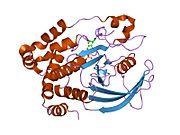








![1l8g: Crystal structure of PTP1B complexed with 7-(1,1-Dioxo-1H-benzo[d]isothiazol-3-yloxymethyl)-2-(oxalyl-amino)-4,7-dihydro-5H-thieno[2,3-c]pyran-3-carboxylic acid](http://upload.wikimedia.org/wikipedia/commons/thumb/d/d5/PDB_1l8g_EBI.jpg/180px-PDB_1l8g_EBI.jpg)




![1nwe: Ptp1B R47C Modified at C47 with N-[4-(2-{2-[3-(2-Bromo-acetylamino)-propionylamino]-3-hydroxy-propionylamino}-ethyl)-phenyl]-oxalamic acid](http://upload.wikimedia.org/wikipedia/commons/thumb/4/43/PDB_1nwe_EBI.jpg/180px-PDB_1nwe_EBI.jpg)


